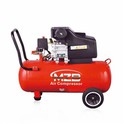1. Working principle
Screw air compressor is an air compressor that utilizes the mechanical movement of the screw to generate gas compression. During operation, there is no direct contact between moving parts, resulting in low noise, low vibration, long service life, and high reliability.
The piston air compressor is driven by a connecting rod, allowing the piston to move back and forth, thereby achieving the process of intake, compression, and exhaust. Due to the upward and downward movement of the piston to compress gas, noise and vibration are relatively high, which can easily lead to mechanical fatigue.
2. Performance
The compression ratio of screw air compressors is relatively stable, and the working temperature is also low, resulting in higher efficiency.
The compression ratio and efficiency of piston air compressors are sometimes limited by factors such as structure and gas, and can decrease, especially under high pressure and high flow rates, where pressure fluctuations are also relatively large.
3. Maintenance
The screw air compressor is relatively more convenient in maintenance. Due to its relatively simple structure, it only requires regular cleaning and oil change.
The structure of piston air compressors is relatively cumbersome, requiring more complex repairs and replacements, resulting in higher maintenance and upkeep costs for the machine.
In summary, screw air compressors and piston air compressors each have their own advantages and disadvantages. Therefore, when choosing an air compressor, we need to choose the appropriate model based on specific usage conditions and needs.
Apr 17, 2023
The Difference Between Screw Air Compressors And Piston Air Compressors
Send Inquiry







